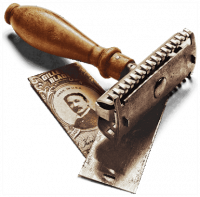- Thread starter
- #81
I don't think the sideways measuring technique is correct because the edges and center neck down. You should be measuring with the narrow end only under the lather slots, and jamming it in less than a millimetre.
How do you explain that I get a gap of approximately .011" on essentially new Fatboys at Position "1"? Are you saying that the gap pinches to .011" at the edges and center, but at the lather slots the gap opens up to .022"; twice as much!?! I would expect no more than a 20% difference using your methodology - from my pictures above. With the gauge across the entire space I got a .010" (the 1st picture) and with the gauge inserted as you suggest (my 3rd picture), I got a .012" gap. This is a difference of 20% which I believe I only got by dis-forming or distorting the razor blade in an area of less support for the blade.
Thought exercise: Shouldn't the blade edge be parallel to the safety bar along the entire edge of the safety bar? If so, why not use the gauge as I have done? If the gauge has to be "jammed" in at only the lather slots (the area of least support for the blade), this is giving you a distorted view of what the gap is along the entire width of the razor head.



